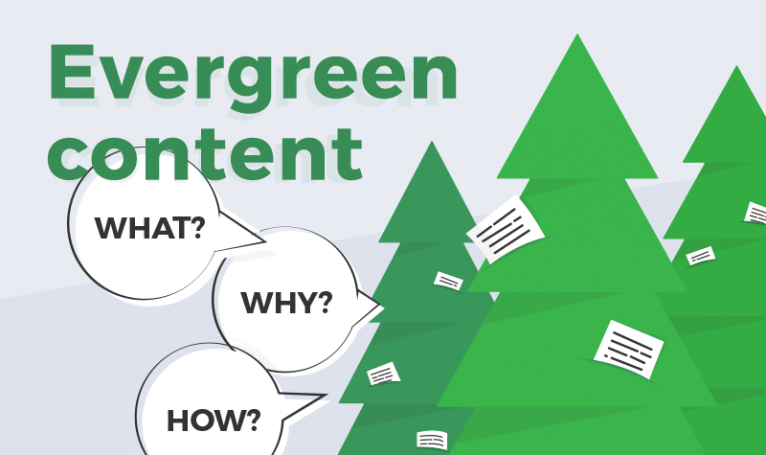Every writer’s dream is to create content that lasts, gets a lot of shares, gets talked about in the industry.
That is what evergreen content is all about, functionality & validity over a longer period of time.
But, such content does not get created every day. When great writing skill and topic expertise gets mixed with the know-how to create evergreen content, that’s when such a piece is created.
While factors like topic expertise and great writing help, the topic selection itself have a lot to do to determine the value and the possibility of going viral of your content, and for the time period, it’ll last. (Just disclosed one know-how to create evergreen content, more to come)
About the topic selection, I’ll go with the evergreen quote – “Quality over Quantity”.
I see many content marketers to get overwhelmed with creating as many blog posts as they can and as a result, they rush through the topic selection process, which is contradictory to creating evergreen content.
You need to put your bigger chunk of effort in topic selection, to find that gem of a topic that your audience is waiting to consume content on.
You yourself first need a strong understanding of why your post is important to your audience and what it can offer to them.
As you can already understand, developing an evergreen content needs considerable time to put into it, and creativity – This is not a get-rich-quick scheme.
But if you can make your way through the process, you’re creating an asset for yourself that will drive traffic to your website for a long period.
And most importantly, it’ll create an AUTHORITY for you in that industry, which significantly helps in the coming days.
That said, I’d like to share my knowledge on the know-how of creating evergreen content, with the correct definition of so.
Table of Contents
What is Evergreen content? Is that same as Viral content?
No, they exactly aren’t the same.
The core definition of evergreen contents is long lasting contents. Content that stays functional and valid over a long period of time.
Whereas viral contents mean contents that get a lot of attention, shares, talk-about in QuickTime. These usually are contents that are written on a very trending topic, take the football world cup for example.

Viral content does not necessarily get having that attention for a longer period of time. In the same way, it’s not impossible for evergreen contents to get that quick attention like a viral content in its primary days but still stay effective in the later days.
Hope that made the confusions clear, and doing so, let’s dig into evergreen content a bit more, since it’s what we gonna talk about for the next 10 minutes or so.
There are some basic and common traits of evergreen contents, like –
- They’re usually in-depth, and go-to resource/solution for the given topic/problem.
- They’re research driven and factual.
- They reflect the audience’s perspective.
- They are engaging with the right visual and other supports.
- They provoke thoughts.
If these traits are there in the content on the right topic, that is likely to stay evergreen.
Evergreen content is such a valuable asset for numerous reasons and is an investment that companies of all sizes should make into.
One evergreen content that reaches a lot of audiences and benefits them, can even double your company/website’s authority in a given industry. Most of the people engaged in that industry will recognize you and respect your words.
You’ll get a lot of mentions across the web known as natural backlinks. It lays a solid foundation for your website to keep the quality content coming that the audience is already eager to read, thanks to that authority you created.
It’s a sustainable and SEO-friendly investment.

Moreover, it’s the kind of content that will drive traffic to your website for years and will continue to be something that people search for.
While it might not bring a whole lot of traffic at one creating an initial spike, it rather will increase traffic steadily through organic search.
Evergreen Content’s Common Format
Though I’m using the word ‘content’ everywhere, I actually mean blog posts.
Now, talking of blog posts, evergreen ones of those usually have some common formats. I mean, there is some type of blog posts that are more likely to stay evergreen.
Such as –
How-To Guides
How-to guides are the most common type of blog posts that stay evergreen. This type of posts is the most popular form of evergreen content. Meanwhile, this post itself is a ‘How-to’ guide (Hope it stays evergreen, fingers crossed).

I provided such information in this piece that is actionable and that is likely to hold its value for years to come. This is such a topic where’s no possibility of drastic change in the coming period. That’s why it likely to stay evergreen if you, the audience finds it useful.
There were two catches. First, provide actionable information that actually helps the audience with what they are trying to do. That’s what How-to article is intended to, help people actually ‘execute’ a particular task.
It’s just not about passing the information which might be just insights. Don’t get me wrong, insights are valuable. But if you’re writing a ‘How-to’ article, make sure the audience is able to execute what they’re reading your article for.
‘Actionable information’ is the catch of writing a successful and possibly evergreen how-to content!
Another catch is, choosing a topic/a problem to solve that’s not likely to face a drastic change in the process of solving that problem in the near future.
Take the tech industry for example. It faces changes so often that it’s very tough to say a certain process that’s working today will work in the near future.
If there’s any SEO guy reading my article, you tell me, the stuff that used to work a year back, does it work now?
Some of them might be, but many don’t. And you don’t know which will work in the near future, which will not.
However, I don’t mean that you shouldn’t write on a topic that might face changes. What I mean is if you want to create evergreen content, you should select such a topic that’s not likely to see a drastic change in the coming days.
Minor changes will be there, I know. You can just update the content in such a case.
Take that SEO thing for example. This industry faces a lot of change, after every search engine (Mostly Google) algorithm update. But one thing stays unchanged – the value of useful content that actually helps the reader.
I can confidently say, no matter how many Google update will take place, but the appreciation of Google for informative, valuable and problem-solving content will never change.
So if you’re an expert at creating such content, and you write a detailed article teaching people how to do so, don’t you think that’s likely to stay evergreen?
Problem Solving Articles
This kind of falls in the category of ‘How-to’ guides. It’s better to say that this is a branch of that. This is more like ‘How to do any whole thing’ vs. ‘How to overcome this problem while trying to do that thing’.

The reason behind mentioning problem-solving articles separately is, people that are in problems are normally more desperate. So if you can solve those critical problems of their, they’re more likely to become a fan, it’s true!
The significance of the problem-solving article is, you have to think from your audience’s viewpoint this time, which is comparatively tougher, so the reward is sweeter.
For example, writing a piece on ‘how to do SEO’ is easy enough for you if you’re an expert at SEO. You tell to write valuable articles, publish guest posts, and build links and so on.
But no matter how detailed your article is, your audience will definitely face common problems trying to do SEO following your article. Some of them will say ‘they are having problems trying to approach webmaster for guest posts’, ‘they are having a problem with robots.txt’ and so on.
Most of them will have some common problems which are your job to identify.
That’s the secret of writing problem-solving articles – you have to understand the audience’s pain point, so you have to walk in their shoe.
First, you have to identify what they are struggling with and offer solutions that are accessible to them.
There’s a significance of problem-solving articles which is, you won’t find much of them that are actually great.
If you google ‘How to do SEO’, you’ll get tons of pieces. But there are not many articles solving the common problems that people face while doing SEO. You have to utilize that gap to make your article get a place in the audience’s mind.
Aside from walking in the audience’s shoe, here’re some places for you where from you can get ideas of your audiences’ problems, and write articles on later –
- Forums, discussion groups, Q&A websites.
- Social media platforms. (Related facebook groups, pages, Pinterest boards, subreddits)
- Comments on your existing posts.
- If you’re a business, look through your customer support logs.
- You can also reach them out directly through different channels.
- Brainstorm.
FAQ Guide
If you can answer your audience’s all frequently asked question in one content, that’s going to be hit for sure.

These questions refer to minor problems but your audience needs to spend a lot of time and dig through the internet to find solutions to.
This often happens to me, and I’m sure to most of you out there. We tend to face minor problems sometimes solving which is actually a piece of cake. But we face a hard time to find the recipe to bake that cake even since it’s really hard sometimes to find the information through the internet.
You as an expert in your industry can utilize this opportunity and make your audience’s life better by answering all these questions in one or a series of articles. As long as people will have those questions, your content will stay relevant and evergreen.
And, where to find these questions again?
Same answer as above. Forums, Q&A sites, Facebook groups and so on are really great places where you’ll find people asking a lot of questions. If you’re popular on facebook or twitter as an expert in your industry, you’ll have people asking you questions directly.
You can collect questions from all these sources and fit them in one or a series of article, and spread out words about that article in relevant places.
Historical Data or Industry History
This is for you if you’re an old player in your industry. If you saw this industry grow right in front of your eyes, you can note your experiences down into a series of articles that many people are interested to know about.
The best thing about history is, they will not change over time like many other cases and therefore, they constitute another great form of evergreen content. Your historical article is not going to go obsolete for any change taking place.
Historical evergreen content is a great idea to prove your authority to people. People will know from these articles that you’re a veteran of this industry and they’ll respect you even more.
I’ll site ‘SEO’ for example again. There are few people that have been in the game from the very beginning of it. They’ve seen all the changes that took place after every Google algorithm update.
They can fit these into a series of content and create something like a timeline. Name of every update, what were the major concerns of it, what things changed after the update, and so – they can note these to create that timeline.
Anyone new in that industry will be overwhelmed to find such gem of a timeline because they’re getting to know the happenings of the industry for the past decade or so. This is something they don’t find every day.
This can also be helpful to analyze the characteristics of the industry that can help the participants of that industry to predict future changes and be prepared. So not only the newbies, the intermediates or experts are going to grab that timeline as well.
The great thing about such historical timeline contents are, they are like red wine, looks more and more authoritative as time passes by. So these are such a type of content that was meant to stay evergreen.
Annual Summary Posts
The theme is same here, like the historical timeline of industries.
The difference is, this time you’ll be reviewing one year only, what happened throughout this one year, how the industry has changed and shaped and so on.
Good news for many of you this time is, you don’t need to be at the veteran level to write such posts, like the previous one.
If you’re in the industry for a decent amount of time, you’ll be able to write such posts that if well executed, are likely to stay there for a year at least.
You can also create a timeline with these posts. Let’s say you wrote a post at the beginning of 2019 titled ‘SEO in 2018 – What worked and what Not’.
At the beginning of 2020, you write another installment of this series – ‘SEO in 2019 – What worked and what Not’.
This will create a series of articles titled may be ‘SEO-What works over time and whatnot’, that if the audience likes the first one, will be anticipating for the next ones.
Thus you’re influencing an evergreen series of articles.
Additional Ideas on Evergreen Article Formats
Why are things the way they are?
Have you ever thought in such a way? Most people don’t, which can be an opportunity to utilize.
There are many things in our surroundings that have been set to do in a particular way, and we’ve accepted it. We keep doing those in that way but never ask why we should do them that way.

If you brainstorm, you’ll find such things in your industry. And if you find such, try to find a better alternative way to do that particular task.
If you really can offer a better solution to a task that’s hassle-full and not-really-effective, but always have been that way, people are going to grab your solution.
All the SEO guys out there know that you’ve to outreach to other website owners and ask them to publish your post as a guest post to their website and link back to your site.
This has been the traditional way of building up a relationship with other bloggers and get links.
But the problem here is the success ratio. The email you’re sending to the website owners is your first email to them, and you’re asking for something in the very first conversation.
Probably that’s why the success ratio is less than 10% in outreaching.
Couldn’t you change this approach? How about offering them something in the very first email?
You might tell them the weak points of their content, how they can make it better, what topic they’re missing to cover etc. There can be many other ways to provide value if you actually want to. Even an appreciation for their awesome post will do.
When you feel there’s actually a relationship you’ve built up, now you might offer them to let you write as a guest blogger for their blog. The chances of hearing an ‘Awesome, why not?’ is much higher this time.
This is not a revolutionary change in the process, but it’s definitely rethought.
People tell you to send as many emails as possible. I tell you not to send bulk emails and randomly spam people, rather emphasize more on targeted people.
Following my process, it’ll take more time on one prospect. But the return for your overall time spent will be higher this time and you’ll be doing things in a genuine way, which will give you peace of mind.
I’m not sure how appropriate of an example it was but I hope I could make you understand what I wanted to mean. If you can offer people something really thoughtful regarding doing a common task, chances are your content will get highly accepted.
Find Hacks to Common Problems
Sometimes our readers face some common problems, the solution to which is there for them, and they’re being okay with that. But, that solution isn’t always ideal which gives you the opportunity to do better.
For example, SEO guys know that in some cases they have to make the outbound links ‘Nofollow’ and they know how to do it as well. But it’s manual and time-consuming.
Rather, you can suggest them a plugin that automatically turns all the links or selected links in an article into nofollow. Life will be much easier for them and they’ll appreciate you for doing such.
Try MythBusting
Were you familiar with the YouTube channel called ‘Mythbusters’ back in 2016? That channel used to be very popular and by the name of theirs, you can understand what they did.
They used to bust common myths of regular life, I mean they experimented to see if the myths were actually true or not. That channel used to be very popular due to their niche of content (Unfortunately they’re closed now).
Myths are something that is prevalent in every industry. And you as an expert can take the opportunity to actually examine this and bust one if it’s obsolete.
The immediate effect of these contents are really overwhelming and they’re going to create a lot of buzz from the very beginning of their time if actually busted correctly.
Actually, even if they’re busted incorrectly, I mean claimed, that’s going to create a lot of hype as well at the beginning. But the effect of the incorrect claim of busting will create a negative impact on your authority, so be aware.
But correct busting of common myths will fetch you positive feedback in the long run.

The great thing about such contents is they make themselves viral along with having the possibility to stay evergreen. That’s because they influence a lot of engagement in the industry as they spark a lot of debate initially and provoke a lot of questions to be asked. This gives you plenty of opportunities to engage in discussion with your target audience and your peers.
And the more the engagements are in content, the more it’ll be talked about and the more shares it will get, creating the possibilities of going it viral.
Suppose if I tell you today that there’s no existence of Google sandbox, which most people believe exist, how much hype it’s going to create in the SEO industry!
People are going to ask me a lot of questions, they’re going to share it on their social media accounts and ask for other people’s opinion on this.
It might create controversy as well, but if I know what I’m talking about and I have data and proof, that controversy will bring positives for me at the end of the day.
However, there’s a catch, which is you really have to know what you’re talking about and you have to have statistics, logic, and science to back you up. You want to use specific examples and stories if possible to make the content interesting.
If done right, myth-busting posts will earn you more credibility, engagement, shares, new backlinks and most importantly, they’ll help you to build thought leadership points which is a cherishable thing.
How to get ideas for Evergreen content?
Now you probably know what type of contents are that are likely to stay evergreen. That said, another challenge is finding ideas to create such type of contents.
Since you are the expert in your industry, the brainstorming task is on you.
Though I have some generic techniques that might bring ease on your task. Here they go –
Closely Observe Trends in Your Industry
Tracking the trending topics in your industry could be a solid strategy to help jumpstart new ideas for content. The trends could hit your brain with great new ideas for fresh content.
On the second thought, they may also give you the opportunity to repurpose old content in the trending shape and re-share it. You could have a gem hidden in your old stack of contents, who knows! Just pour that old wine into a new bottle and serve.

To follow trending topics more effectively, you should also have an eye on people’s reaction to the trends, along with the trend itself.
Closely observe what people are saying in the threads of trending articles and topics. Are they demanding for a freshly brewed content explain the trend? Awesome for you. Give them what they want.
Are they having problems with little things? Take the opportunity to create a full-blown piece of content in the form of a response, instead of responding there to solve their problem.
It’s your industry, you know how to play it better.
Reverse Engineer the Top Content in Your Industry
This is another great place to start to look for ideas. You can track the top contents in your industry with tools like Buzzsumo and see how they are performing.
You’ll find holes in them if you look closely. Go through those contents yourself and you’ll have some points where you think a not-so-expert will have questions about.
You can freshly brew a content making sure those holes are not there in your content and place it in appropriate places.
You may also look at the comments left there and try to find out how you can offer something new in those discussions.
All these will leave you thinking and hopefully you’ll generate ideas out of it.
Have a Peak Where Your Audience Hangs Out
I consider this as one of the best strategies to find out what your audience wants. And I can’t stress this enough how important it is to stay active in the places where your audiences’ are.
If you think I’m overrating this, just head on to Quora and subscribe into the threads of your industry. You’ll see how much questions people are asking every day about new topics. You’ll find hundreds of gaps to fill that will bring you thousands of visitors.
Some places you want to stay active are –
- Q&A sites like Quora and others.
- All the forums of your industry.
- Related Facebook groups and pages.
- Linkedin groups.
- Subreddits on Reddit
And where you feel relevant….
Being in a place where your audience is will let you see what they’re talking about, what questions they have, what are the type of contents they’re liking more and sharing more (like step-by-step how-to guides, informative contents, etc.).
From these places, you will have a much clearer idea of what exactly your audience wants to see. The rest is just about placing those in front of them.
You can also take the opportunity of doing some marketing of yours in those places, but only when feels appropriate.
Provide authentic answers to your audiences’ question and when it feels appropriate, provide the link to a post of your site which you think answers that given question.
Nice way to get a backlink and some visitors, huh.
That being said, you don’t want to be that guy at the party whom everyone tries to avoid as he is always selling something. So don’t do this too frequently.
Cheat Trick: Try Repurposing
Tried everything but ideas are just not happening now? Let’s cheat.
Grab one of you decently popular content and repurpose it into another form. Summarize your blog post into an infographic, or do the reverse, elaborate your infographic into a blog post.
Since YouTube videos are amazingly effective these days, you can try briefing your post into a YouTube video as well.
Also, you can also encourage your audience to ask you their questions and later come into facebook live and answer those, or make a question-answer video and upload it to your YouTube channel, or make a podcast even, instead of writing answers to all those questions which is time-consuming and tiresome.
These repurposed forms help you create more content without much effort and help you get the most out of your top performing work.
The catch here is getting all that you can out of a topic our audience loves and responds well, by making different forms of content on that same topic.
Smart cheat, eh?
Additional Tips for Creating Evergreen Content
Make Them a Go-To Resource
If you’re still here, do you know how many words you’ve already read, with some more to come?
More than 4,000 words already, on this single topic. Pretty long for one little topic, eh?
I don’t know whether you like this or not (probably yes, that’s why you’re still reading), but I recommend this, I recommend making a content a go-to resource for a given topic.
Before starting to write this content, I did a little research, to see what other experts had to say on creating evergreen contents.
I went through all of them and I liked some of the tips they shared. But those were coming from different places, which is much harder to put together ultimately.
But I had other ideas. I wanted to make sure that someone who’s reading my content, don’t have to go anywhere else to find further explanation or information. That’s why I’ve explained all these in details and covered every little thing, which took much more effort of mine.
But, I’m ready to put this effort upfront as an investment, so should you.
Aren’t you liking that you’re getting everything about creating evergreen content in one webpage, described in one ‘tone’?
Your audience loves this too. They’d love to get every information coming from one single source. Because information coming from different sources are much harder to put together due to the difference in the way of their presentation.
So whatever topic you’re writing on, make sure you go deep and try to cover all the stuff, so your audience does not have to go anywhere else.
Make Them Engaging and Relatable
No one likes a wall of words only.
It’s important to present information in a fun manner these days as people have become very skeptical.
To get their attention to your content, you need to make it engaging with visuals, videos, charming writing tone, humor, and relatable example and so on.
The irony is, important information that is presented in a boring way, are often overlooked. And crap information that is presented in a fun way is often gone through at least once.
Maybe that’s why views on actually valuable and informational videos on YouTube is lower than Logan Paul videos. (No offense though)
But, it is what it is, we have to accept it.
So find ways to make your content more engaging so that people have fun while consuming that valuable information.
Find a Way to Acquire Instant Traffic
Time to time I find some amazing articles on the internet that really didn’t get the kind of response that it deserved. These contents were amazing in quality but it reached barely a few people, that’s where things went wrong.
The importance of placing your amazing content in front of the right people is almost as important as making that content ‘Amazing’.

That said, the initial boost tends to be the tougher part so you need to play well here. Once your new content gets that initial recognition, it circulates automatically by people’s shares and talk-about.
Remember I suggested you stay active in the places where your audience hangs out? Do some subtle marketing there.
Give a buzz to people saying ‘Hey, I’ve published this amazing content on ‘x’ topic, check it out’. If you already gained some credibility that I told how to gain, people ‘will’ follow your link and have a look, what the expert has to say now.
Make a quick trailer video and upload it to YouTube with the link of your content in the description box. And in the video intentionally skip some important stuff and invite people to read the post to know them, just every other trailer does.
If you have a subscriber list, initiate an email blast to let everyone know that you’ve published a new post on this topic and write the email in such way that they cannot but pay a visit.
Email marketing is a very effective way to jumpstart getting traffic. I myself everyday read 3-4 posts after getting notified about through email.
If you can, find other ways to provide that head starts to that amazing content you just created. In short, make sure as much possible see the content when it’s first out.
The content itself will do the rest and take it from there by earning ‘shares’ if it’s actually amazing.
The Bottom Line
The bottom line is, you can’t create evergreen contents if you don’t know your audience properly. All I discussed will help you develop a thought pattern on how to make content more effective.
But it’s you who needs to find that idea for the content formats that I suggested to brew one hell of great content.
Every niche is different, so don’t get generic here. Think according to your niche and audience.
And be creative here. You are not must-to-follow what I suggested. Your one unique idea that doesn’t fall into any category I mentioned, could be evergreen, yes it could be. In fact, that’s what most evergreen contents have – uniqueness.
So don’t be afraid to try your unique idea that doesn’t comply with any ‘expert’s opinion.
Start from the bottom with brainstorming, researching, and planning. Put a bigger chunk of effort here.
Finally, be patient. Evergreen contents are not created every day. If they were, they’d lose their nobility.
Try to deliver as much value possible through your contents. Leave the rest to the audience. They themselves will make those viral and evergreen that deserves.

